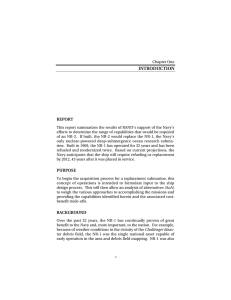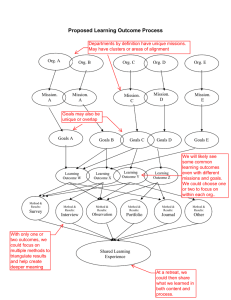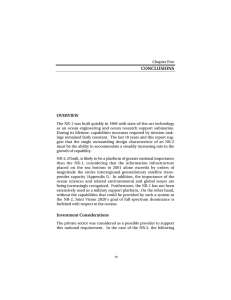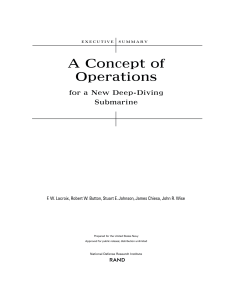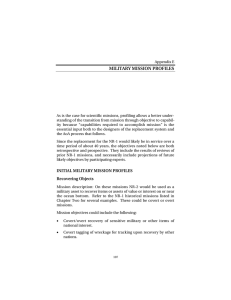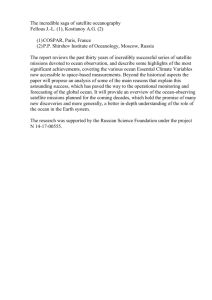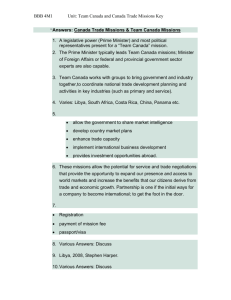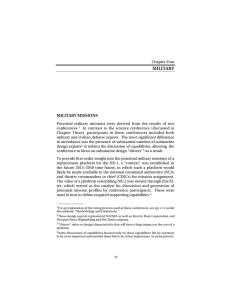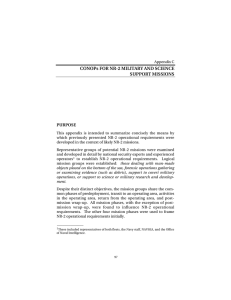SUMMARY BACKGROUND
advertisement
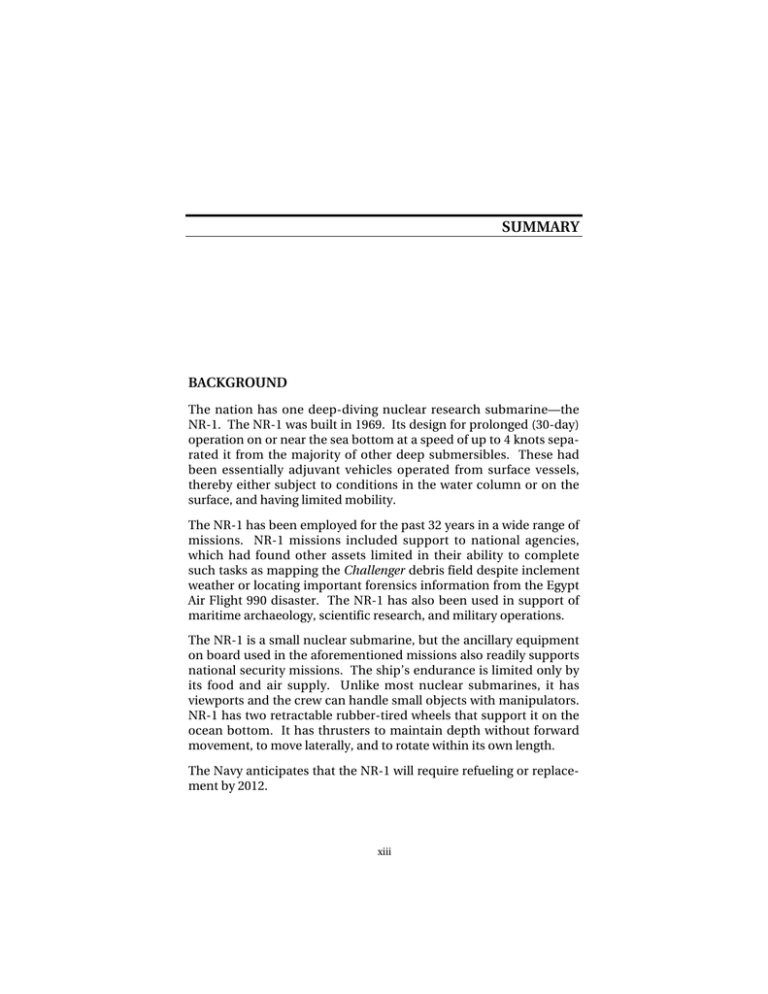
SUMMARY BACKGROUND The nation has one deep-diving nuclear research submarine—the NR-1. The NR-1 was built in 1969. Its design for prolonged (30-day) operation on or near the sea bottom at a speed of up to 4 knots separated it from the majority of other deep submersibles. These had been essentially adjuvant vehicles operated from surface vessels, thereby either subject to conditions in the water column or on the surface, and having limited mobility. The NR-1 has been employed for the past 32 years in a wide range of missions. NR-1 missions included support to national agencies, which had found other assets limited in their ability to complete such tasks as mapping the Challenger debris field despite inclement weather or locating important forensics information from the Egypt Air Flight 990 disaster. The NR-1 has also been used in support of maritime archaeology, scientific research, and military operations. The NR-1 is a small nuclear submarine, but the ancillary equipment on board used in the aforementioned missions also readily supports national security missions. The ship’s endurance is limited only by its food and air supply. Unlike most nuclear submarines, it has viewports and the crew can handle small objects with manipulators. NR-1 has two retractable rubber-tired wheels that support it on the ocean bottom. It has thrusters to maintain depth without forward movement, to move laterally, and to rotate within its own length. The Navy anticipates that the NR-1 will require refueling or replacement by 2012. xiii xiv A Concept of Operations for a New Deep-Diving Submarine THIS REPORT This report summarizes the results of RAND’s support of the Navy’s study to gain insight into the range of operational requirements for an NR-1 replacement. RAND’s role in this effort was to assist the Navy in identifying the range of both scientific and military missions a follow-on to the NR-1 would likely be required to execute in the future and to assist the Navy in establishing the range of capabilities that would have to be incorporated in the NR-2 1 to accomplish those missions and to prioritize both missions and capabilities. The other issues that presented themselves in the course of the study and were addressed by RAND included the need for a follow-on to the NR-1, investment considerations, the need for manning, and initial design concepts. The study integrates and prioritizes projected deep-submergence missions and capabilities over the period 2015 to 2050. The result is a potential concept of operations (CONOP)—including both scientific and military missions—for an NR-2. The CONOP developed for this report describes and prioritizes these missions. Required NR-2 operational capabilities are associated with missions. Therefore, these capabilities can be prioritized in the course of design trade-off studies. The basic framework for the study was provided by the results of three conferences, where experts in both science and national security contributed to defining a total of 28 likely future mission profiles, which were then used to derive the prioritized designdriving capabilities for a replacement ship for the NR-1. RAND assisted the Navy by proposing this framework for prioritization of important capabilities. RAND also summarized the effort and developed for the Navy the general military, scientific, and support CONOP for a possible follow-on system to the NR-1. RAND also developed overall conclusions regarding the need for a system that could incorporate the aforementioned capabilities. ______________ 1 NR-2 is used here to designate a potential replacement system for NR-1. Summary xv SUPPORT OF SCIENCE MISSIONS The NR-1 has demonstrated its value in support of science by increasing the range, endurance, and power available on the seabed compared to other available means. Also, NR-1 was valued in operations on the ocean floor and in the water column for its speed, flexibility, and ease of operation under adverse conditions. Scientists who participated in the study anticipated applications for NR-2 in all branches of ocean science. They also foresaw the ability to do science more quickly, thoroughly, and accurately. The NR-2 will support all areas of ocean science and national oceanographic research on the ocean bottom. This study determined the likely science research priorities over the lifetime of the NR-2, as shown in Figure S.1. RANDMR1395-S.1 1.0 0.9 0.8 0.6 0.5 0.4 0.3 0.2 0.1 ea P no hy gr sic ap al hy Ic e sc ie nc e G eo ge lo op gy hy an si d M cs ar in e bi ol og y en gi O ne ce er an in En g vi ro nm sc en ie ta nc l e oc ea Ch no em gr ic ap al h At m y os sc phe ie ric nc e ar Ma ch r i eo tim lo e gy 0 oc Mission priority 0.7 Science mission Figure S.1—Science Research Mission Priorities xvi A Concept of Operations for a New Deep-Diving Submarine SUPPORT OF NATIONAL SECURITY MISSIONS The future use of the NR-2 in support of national security derives from two predominant considerations. First, the ocean bottom has become the infrastructure foundation on which the international telecommunications industry has come to rely, with the concurrent increasing importance of the ability to protect and ensure this infrastructure. Second, just as the United States has maintained the capability to understand the extent of its adversaries’ use and exploitation of space, the country should not cede its ability to provide an understanding of these same aspects with respect to the ocean. National security mission priorities result from the fact that the NR2, if built, would be the only dedicated national asset capable of this national security mission set associated with the sea bottom. Figure S.2 shows the prioritized national security missions for an NR-2 as determined by this study. RANDMR1395-S.2 1.0 0.9 Mission priority 0.8 0.7 0.6 0.5 0.4 0.3 0.2 0.1 0 Protection Offensive of national information assets on operations the seabed IPB Forensics Expanded investigation ISR Military mission Figure S.2—Military Mission Priorities Defensive Covert information operations operations Summary xvii STUDY FINDINGS Mission After examining a full range of likely future missions in support of both military and science, the study concluded that, if built, the NR-2 would be of national importance; it would be the only naval asset with a dedicated capability of operating on or near the ocean bottom2 to: • Support national oceanographic research on the ocean bottom. • Enable national understanding of our adversaries’ exploitation of the ocean bottom. • Enable the protection of U.S. national assets on the ocean bottom. Lack of NR-2 capability will forfeit this mission. Capabilities To execute the aforementioned mission, the following system capabilities are required: • The ability to operate, directly or through an adjuvant vehicle (remotely operated vehicle/autonomous undersea vehicle— ROV/AUV), on or near the seabed at depths to 1,000 meters or more, with sufficient mobility over the bottom to cover tracks hundreds of miles long and to maneuver precisely over the seabed. • The ability to operate an adjuvant vehicle (to maximize mission flexibility and ability to incorporate new technologies). ______________ 2 Although other sources of capability may be available, it is our sense that they may not be as efficient or cost-effective as the system discussed in this report. Alternatives to NR-2 other than a manned submersible may be precluded by simultaneous requirements for depth, endurance, stealth, speed, reliability, and heavy-lift and manipulation capabilities and by the need for the ability to operate on or near the bottom with intelligent responses to novel situations. However, this matter is beyond the scope of this report and should be resolved in an analysis of alternatives (AoA) study. xviii A Concept of Operations for a New Deep-Diving Submarine • Operator-in-the loop (required for intelligent response to novel situations and reliability over the periods of interest). • Stealth to penetrate and operate undetected over a period of days in hostile waters. • Sufficient mobility between theaters to be responsive to both theater and national command authorities (NCA) 3 taskings and to explore areas of interest in a timely manner. • Design flexibility/adaptability—the ability to accommodate additional missions without redesign or modification to the basic platform. • Fine object manipulation ability, directly or through an adjuvant vehicle. • Precise navigation ability to locate or relocate objects on the seabed. RAND Conclusions RAND concluded that these capabilities should be developed because • the missions requiring undersea capabilities in national security and homeland defense will grow in scope and importance, and will exceed the capabilities of the NR-1; • national oceanographic research support will remain important; and • the aforementioned capabilities will support the National Oceans Policy and would be consistent with the “Oceans Act of 2000” (see Appendix H). RAND also concluded that the range of these essential capabilities described above will not be available from any single source other than a follow-on submarine to the NR-1.4 ______________ 3 “National command authorities” (NCA) refers to the President, the Secretary of Defense, or their deputized alternates or successors” (DoD, 1994). 4 See footnote 2. Summary xix Investment Considerations The private sector was considered as a possible provider to support this national need. In the case of the NR-2, it is the preliminary judgment of the RAND researchers that 5 • the private sector will not be able to provide the range, breadth, and depth of expertise and information that the NR-2 will likely be tasked to provide because it will be unprofitable; • information that the NR-2 will provide will not or could not be reliably collected by the private sector or alternative platforms because it would be too operationally or technologically demanding; • the information the NR-2 could be called on to collect cannot or will not be collected by other platforms because of risk or other constraints; and • NR-2 will at times be required to provide U.S. agencies with specific tailored products independently or combined with other sources. DESIGN CONCEPTS Two alternative submarine design concepts for NR-2 emerged from this study. Both concepts would share design flexibility, ample payload capacity, and the ability to operate at depths to 3,000 feet and to bottom. Both would be able to operate an adjuvant vehicle with a manipulator and would themselves have fine manipulators. Both would have a burst speed capability of 15 to 20 knots. Neither would carry weapons or would have shock hardening. Under-ice capability would increase versatility to scientists by allowing operation over a wider geographic area. One design concept is for a submarine capable of autonomous operations under all conditions. This submarine would have transit speed (15 to 20 knots) to enable timely response to NCA tasking; ______________ 5 RAND recommends the issue of obtaining these required capabilities commercially be further examined in the course of the AoA study. xx A Concept of Operations for a New Deep-Diving Submarine endurance (about 60 days) to give it useful time on station; and, for missions in hostile waters, enough stealth (state-of-the-art acoustic and magnetic quieting) to avoid encounters during its mission. An alternative design concept is for a submarine capable of autonomous operations under all but the most stressing conditions. It would have a transit speed of 10 to 15 knots, about 45 days of endurance, and acoustic and magnetic quieting comparable to the SSN-688 nuclear attack submarine. It would be acoustically quiet at low speeds (6 to 10 knots) but might be relatively noisy at higher speeds. It would be designed for SSN tow or “piggyback.” The SSN escort would compensate for the greater detectability of NR-2 in two ways. First, the NR-2 would spend much of the mission inoperative, passively mated to the SSN, making the NR-2’s higher-speed signature moot. Second, when the NR-2 was operating, the presence of the SSN would protect the NR-2 and deter potential attackers. This submarine could perform most military missions autonomously. It could, for example, autonomously inspect bottom objects on the U.S. continental shelves. In response to urgent NCA tasking it could be towed into an area of interest, and the SSN escort could recover it after it performed its mission. The SSN would remain in the region as the NR-2 conducted its mission. Both design concepts robustly support the majority of ocean science mission needs. The RAND team acknowledges the support for under-ice capability that was expressed by civilian experts and reflected in the body of the report. Absence of under-ice capability is based on the following key points: • The inclusion of under-ice capability requires compromise; other capabilities would be displaced in this small submarine to accommodate the additional ship control and safety features required for under-ice operations (as a result of the proposed concepts of operations the redundancy needed for operation under the ice will be included in both design concepts). 6 ______________ 6 The assessment of relative impacts of specific capabilities on design is outside the scope of this report. The RAND team recommends that the Navy explore the tradeoffs associated with under-ice capability for an NR-1 replacement. Summary xxi • Arctic capability affects branches of science to varying extents; also, current and likely future methods are available to obtain needed information in the Arctic, for example, ice thickness. • While many important science missions for the NR-2 could be under-ice, there remains ample science to be supported in the open ocean. Both design recommendations stress the need for the NR-2 to strongly support the widest synergetic selection of science and military missions.7 • Experts see no current need for under-ice capability for military missions. Manning To be successful, NR-2 must be a manned vehicle for at least two reasons. The NR-2 mission has implicit in it the requirement for responsive evaluation of potentially unprecedented information and extemporaneous mission events—that is, analysis and evaluation of information. In addition, one of the principal capabilities that will assure NR-2 effectiveness over her lifetime is her ability to employ highly capable ROVs, which can be modernized as required to keep pace with technology over her lifetime. Manning the vessel is the key to the capacity for in-situ analysis/evaluation/reaction, ROV employment, and mission reliability. ______________ 7 See Assessing the Benefits and Costs of a Science Submarine (Meade et al., 2001) for an amplifying discussion of the benefits of submarines to science in the Arctic.
